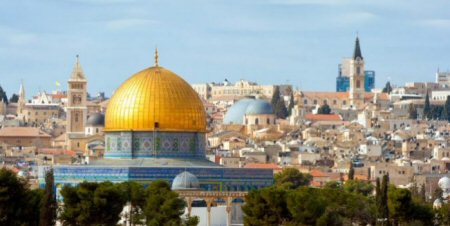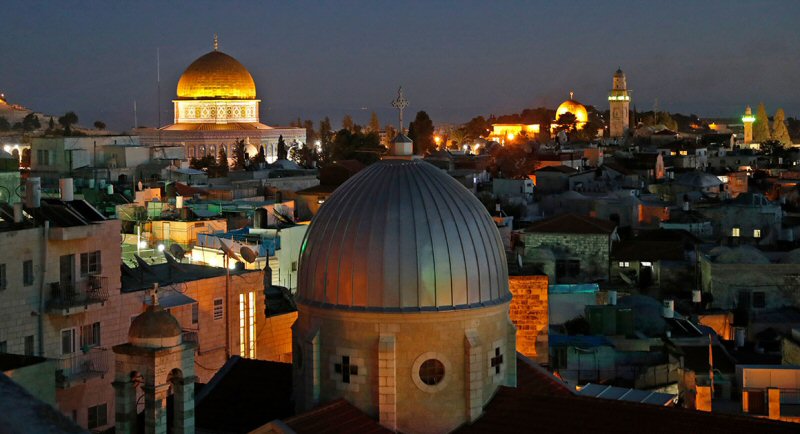Mustafa Abu Sneineh & Sondus Ewies – Middle East Eye
Residents and archaeologists decry plan, saying it will promote illegal settlement and ruin the Old City.
The skyline of Jerusalem’s ancient Old City is set to be altered dramatically by a “racist” cable car that critics say would blight the historic panorama and strengthen Jewish settlement in Palestinian neighbourhoods.
Israel’s housing cabinet, a governmental body, approved the cable car plan, Monday, despite objections that the transitional government currently in place, after the September elections, cannot green light such a project.
Running from the Old City’s Dung Gate to West Jerusalem, the Israeli government says the cable car would help ease traffic in the city and could transport 3,000 passengers an hour, at peak times.
In January, various Israeli bodies earmarked 200,000,000 Israeli shekels ($54,400,000), to see the project completed.
However, Palestinian residents of occupied East Jerusalem, archaeologists and architects say the cable car would severely damage the city’s landscape and contribute to settler group ELAD’s illegal Jewish settlement expansion in the neighbourhood of Silwan.
Settlers’ Legitimacy
Aviv Tatarsky of Ir Amim, an Israeli Non-Governmental Organization researching the Israeli-Palestinian conflict over Jerusalem, told the Middle East Eye [MEE] that a cable car is not the answer to the heavy traffic, and that the project has political layers aimed at giving legitimacy to settlers in the area.
Israel has occupied East Jerusalem since the 1967 war, and settled hundreds of its citizens there, in contravention of international law. The Old City and the adjacent neighbourhood of Silwan lie in the city’s East, which the Palestinians seek as the capital of a future state.
“The project is a way to whitewash Israel’s taking of areas in Silwan to use for archaeological and touristic reasons,” Tatarsky said.
By bringing in tens of thousands of visitors to Silwan, the settler presence in the area would start to become normalized, he said.
Some 2,500 Israeli settlers live in the East Jerusalem neighbourhoods of Silwan, Ras al-Amud and Sheikh Jarrah, dwarfed by the 150,000 Palestinian residents there.
In Silwan, 500 settlers live under heavy police and private security protection, among 25,000 Palestinians.
Several Palestinian families, that have lived in Silwan for generations, have been evicted from the area, by Israel, to create an archaeological park there, and to accommodate Jewish settlers.
The final station of the cable car, near the Dung Gate, will be built above a building owned by controversial settler group ELAD, which manages the City of David archaeological park and builds Jewish settlements in the neighbourhood.
“If someone wants to go to the Western Wall of the Old City, they have to go through the ELAD activity centre. This project will give ELAD legitimacy and influence, as it is taking part in a governmental project. This is the political reason for why the government is doing this project,” Tatarsky said.
Disturbing Old City’s Panorama
In total, the cable car will have four stations stretching from West to East Jerusalem, via Mount Zion. The Dung Gate station, in the East, will lie beside the Old City’s southern wall, close to Al-Aqsa Mosque, the third holiest site in Islam.
Moshe Kahlon, Israel’s finance minister and head of the housing cabinet, said the cable car would make the Western Wall, the holiest site in Judaism, more accessible for the public.
“This is what the occupation wants, to cover the historical buildings that prove other people exist in Jerusalem.” – Fakhry Abu Diad, Silwan resident
“We’ve waited 2,000 years [to return] to the Western Wall, and it’s impossible that heavy traffic prevents thousands of people from praying, visiting and taking part in military and national ceremonies that are taking place there,” Kahlon said.
Fakhry Abu Diad, a resident of Silwan, told the Middle East Eye that the project is the biggest Israeli plan yet “to Judaise Jerusalem.”
“It will block and disturb the panorama of the Old City, including Muslim and Christian buildings, and this is what the occupation wants, to cover the historical buildings that prove other people exist in Jerusalem,” he said.
The cable car will run for 1.4 km, passing over the Palestinian neighbourhoods of Abu Tor and Jurat al-Einab, and stopping off on Mount Zion, where several properties are owned by churches of various denominations.
Each car will be able to carry up to 73 passengers on each journey, with 3,000 people transported every hour.
Naser Hidmi, the head of the Jerusalem Anti-Judaisation Committee NGO, told MEE that Israel’s sole objective is to “control the place and show it as a modern Jewish place.”
“It is a racist cable car, and it will increase the number of Jewish settlers at the Dung Gate, and it would destroy the historical picture of Jerusalem,” Hidmi said.
Emek Shaveh, an Israeli archaeological NGO, said in a video that hard-to-access sites in Venice and the Acropolis in Athens did not lead to installing a cable car in these tourist cities.
The NGO, which is appealing the housing cabinet decision, warned that the historic centre of Jerusalem, which is packed with centuries-old buildings, will be blighted by the modern cable car.
Raf Sanchez – The Telegraph
Many Palestinians see the plan as an effort to entrench Israel’s presence in east Jerusalem, which most of the international community considers to be Palestinian territory under Israeli military occupation.
The construction is also likely to cause disruption to residents of the Palestinian neighbourhood of Silwan, who will find the cable being built above their homes.
Other critics have taken aim at the plan not because of its politics but because they believe it will be a modern eyesore that will blight the iconic Jerusalem skyline and spoil views of the Dome of the Rock and the turreted walls of the Old City.
Architects and historians have decried the plan as “Disneyfication” of a historic area sacred to Judaism, Islam, and Christianity.
United Nations Educational, Scientific and Cultural Organization [UNESCO], the global heritage body, has also protested the plan as a threat to the “authentic character” of the Old City.
Opponents of the plan have vowed to sue the government over its decision and the case is likely to be taken up before Israel’s supreme court, potentially heralding a lengthy legal battle that may postpone construction.
Dr. Hanan Ashrawi, member of the Executive Committee of the Palestine Liberation Organization (PLO) said, according to WAFA, that the Israeli cable car project is an “obscene violation of the cultural, historical, spiritual, geographic & demographic character of Jerusalem. It is also an illegal assault on the occupied Palestinian city and its people who have been living there for centuries.”
Edited for IMEMC: Ali Salam
6/11/2019 – Lands East of Jerusalem Seized for Settlement Expansion



